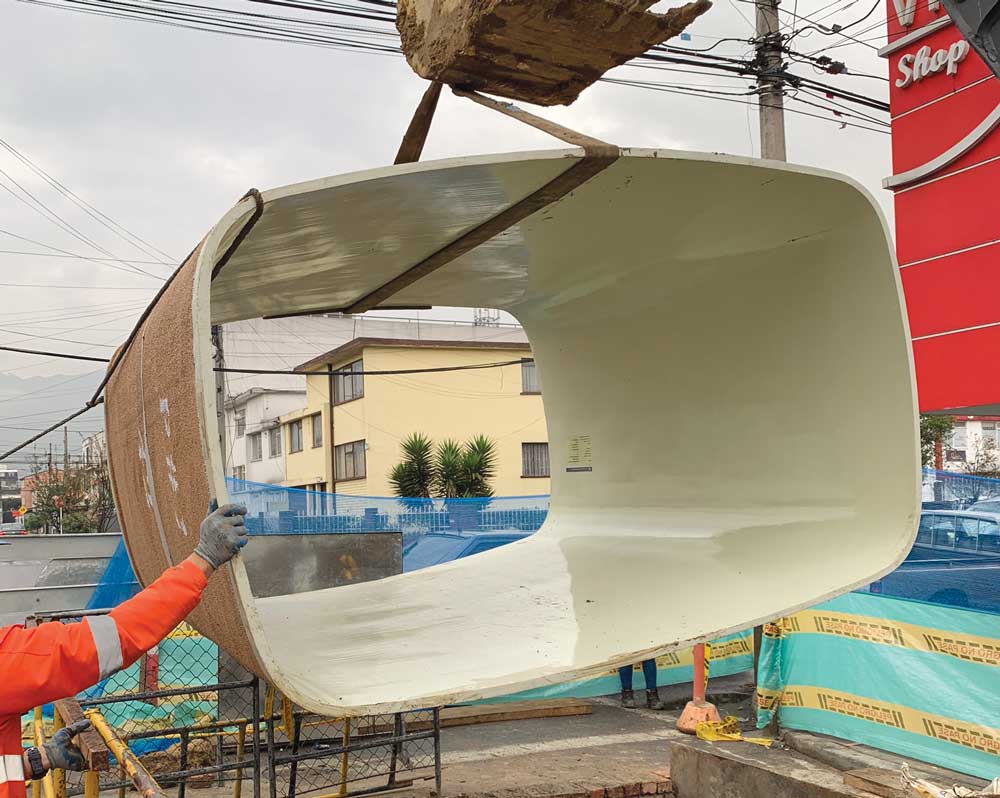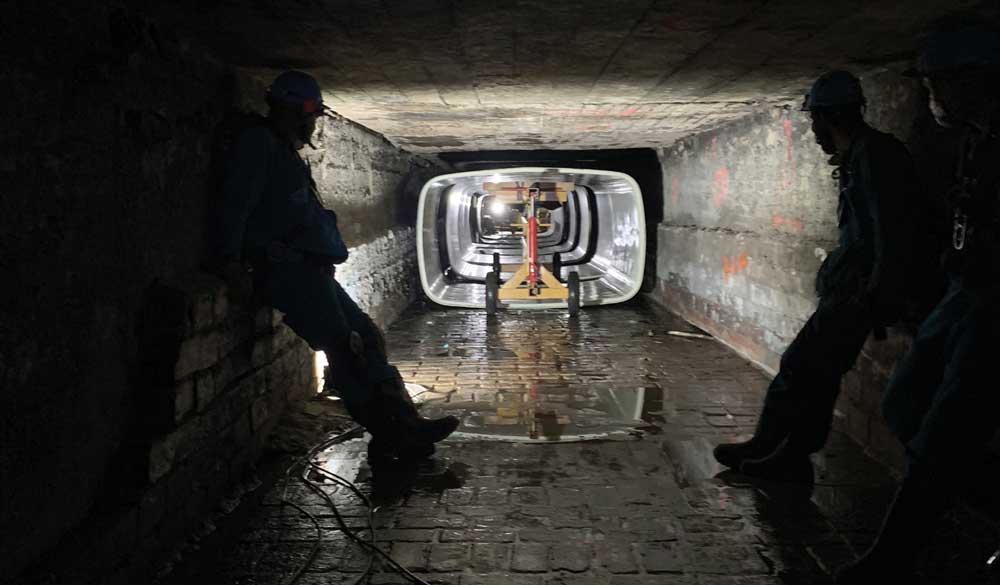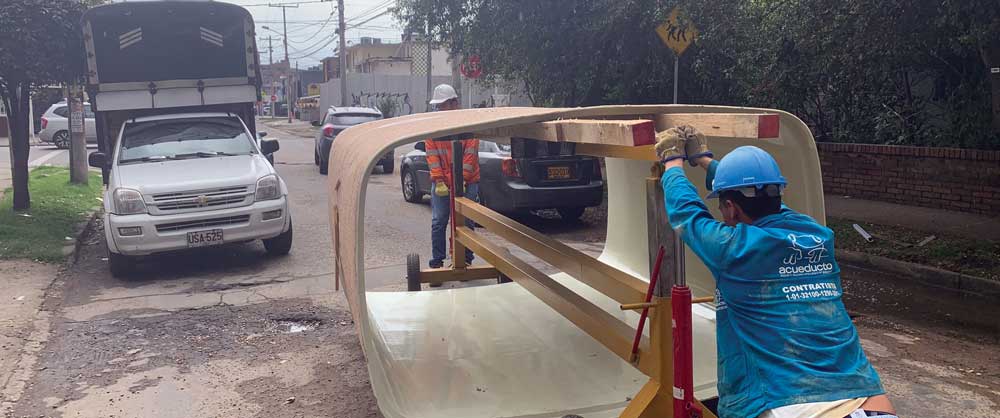GRP Panel Lining in Bogotá, Colombia
GRP Panel Lining in Bogotá, Colombia

Written by Timwebb , SVP Channeline -international.
Bogotá, Columbia, has become the political, economic, administrative and industrial center of Columbia over the past few years.
Established as a City by the Spanish in 1540 and originally names Santafé (Holy Faith), Bogotá is now home to around 8 million residents with an estimated floating population of more than 4 million.
Bogotá is located on a high plateau, called Bogotá savanna, in the Eastern Ranges of the Andes at an elevation of 2,640 m (8,660 ft) above sea level. The Bogotá River crosses the savanna and Tributary rivers form valleys where villages lie and whose economy is based on agriculture, livestock and artisan production. The savanna is bordered to the east by the Eastern Hills that run north south and contain the Guadalupe and Monserrate hills. The western city limit is formed by the Bogotá River, reportedly, one of the most polluted Rivers in the world.

In the 1970s, wastewater was becoming an increasing problem. All of the City’s untreated wastewater was being discharged into the Bogotá River and, ultimately, the reservoir behind the Muña dam. The community of Muña brought a lawsuit against the Water Board and the district government for negligence. Agreement 171 (Convenio 171) called for Regional Government and Bogotá Waterboard to finance and construct the upgrade and expansion of the Wastewater Treatment Plant (WWTP)and to construct the new interceptors to the forthcoming Canoas WWTP.
RELATED: Ross Bay Revitalization – Rehab Under a Historic Cemetery
During a period of approximately 30 years from the early 1970s through the 1990s, Bogotá’s water management focused heavily on improving coverage and quality of water supply sanitation services while also improving financial and technical sustainability. As a result, the Bogotá Water Board provides above 99 percent coverage for water, sewage and drainage services.

Bogotá has an estimated 8,000 km of sewer collectors and interceptors, most of which are coming to the end of their service life. Most sub-surface infrastructure is buried beneath highly populated areas under narrow streets, making traditional open-cut repair or replacement difficult and disruptive. This coupled with the push to separate as much of the Storm and Sanitary system as possible has pushed the Bogotá Water Board to look seriously at trenchless construction and rehabilitation to renew its assets and build new modern sewers.
The first trenchless program, Rehabilitation of La Vieja and Las Delicias Sewer Pipelines was tendered as a public bid in 2017 and included cured-in-place pipe (CIPP) lining, spiral wound and microtunneling technologies. The project also included the rehabilitation of 861 m (or 2,825 ft) of Twin Box Culvert that is buried underneath the busy, narrow streets of the Barrios Unidos District and Discharges into the Salitre River. Two rectangular structures were constructed with brick inverts and concrete walls and crown.
RELATED: Grouted-in-Place Panel Lining – Rehabs Stormwater Relief Tunnels
The twin box culvert is classed as critical infrastructure as it is used to drain storm water from an area that is prone to flooding, due to heavy rainfalls in the mountains to the east of the Barrios Inidos District. Further challenges were met due to the twin box structures having a curves section located directed underneath a four-lane highway at the downstream end.

After, reviewing all of the available technologies available to structurally rehabilitation the 2,500-mm x 1,700-mm (100-ft x 68-in.) rectangular host culvert it was deemed that glass reinforced panel lining offered the most suitable solution as it is not only a fully structural repair but could easily accommodate the curve section. Also, the fact that this lining system does not require proprietary or expensive equipment for the installation.
Following many months of negotiation and submittal approval, Channeline International was chosen as the lining system and technical support supplier.
The Channeline International GRP System is a bespoke, custom-designed and engineered, liner that offers fully structural that can be manufactured to match the existing host pipe geometry, hence offering improved hydraulic capacity.
Production of the lining system commenced in June 2019 and the GRP panels were shipped via ocean freight and installation of the liner started in September, following all preparation works.
The GRP Liner was supplied as a 2,320-mm x 1,520-mm ID liner with a 38-mm wall thickness and a cementitious grout was used to backfill the annular space between the host pipe and newly installed GRP liner.
The liner installation was performed from one access shaft in the center of the project limits, minimizing disruption to the surrounding commercial businesses and allowing for minor traffic re-direction, which is always a major consideration in Bogotá as traffic congestion at the point where residents are only allowed to drive their personal vehicles every other day.
Channeline technical sales manager Andy Sherwin worked with Union Temporal Alianza 1079, a local Alliance of several Contractors including YS Construction and PAVCO to offer construction procedures and technical support on the project.
Sherwin said of the project, “This is one of the most challenging yet rewarding projects that I have been involved in during my 20-year involvement with Channeline. Not only did we manage to get through the language barrier with Engineering and Construction Procedures, the logistics of shipping pipe into a new country. Training new installers that do not have access to materials and tools that we take for granted in our everyday life in North America. The crews were incredibly hard working and adjusted to the challenges easily. The project proves that sometimes a “Low Tech” lining system can offer huge benefits globally, as it can be adapted to be used in any environment, no matter the socio-economic group.”
RELATED: Channeline International Achieves ISO 16611:2017 Certification
During construction, in late September, heavy rain flooded the jobsite as the Salitre River surcharged. The contractor was safely able to remove or tie down all equipment in the culverts and as all GRP panels had been secured into place with blocks, the lining system was not damaged or affected once the floods had receded. After a quick cleanup and removal of debris, the crews were able to re-commence the installation.
The project was completed in February 2020 and was deemed a success by both the Bogotá Waterboard and the Contractor Alliance.
Channeline are proud to have been a part of this project and look forward to more work in South America in the coming years
